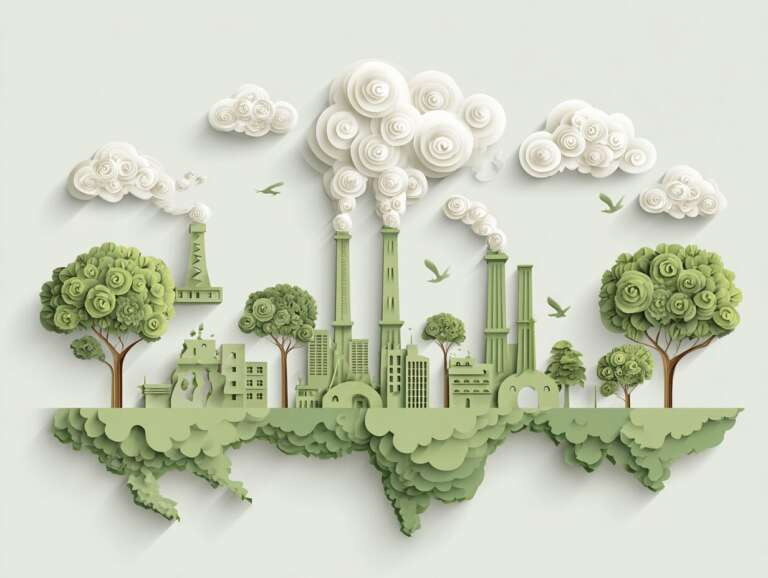How much are we willing to pay for the air we breathe? As global temperatures rise, the economic toll of CO2 emissions is becoming increasingly evident. From devastating natural disasters to skyrocketing healthcare costs, the financial implications of climate change are staggering. The reality is shocking: the longer we ignore these costs, the more we jeopardize our future. This article delves into the economic challenges posed by CO2 emissions and what they mean for businesses, governments, and individuals alike. By understanding these costs, we can better navigate the path to a sustainable future.
TL;DR: CO2 emissions have far-reaching economic impacts, affecting everything from infrastructure to public health. Investing in sustainable practices can mitigate these costs and promote economic resilience. Understanding the financial implications of climate change is crucial for informed decision-making.
The Direct Costs of CO2 Emissions on Economies
Let’s get straight to the point: the direct costs of CO2 emissions are staggering. Natural disasters linked to climate change—think hurricanes, wildfires, and floods—are not just tragic events; they are economic catastrophes. In the U.S. alone, the National Oceanic and Atmospheric Administration (NOAA) reported that climate-related disasters cost the economy over $1 trillion in the last decade. That’s right: $1 trillion.
Disaster recovery, healthcare expenses, and infrastructure damage are just the tip of the iceberg. For instance, after Hurricane Harvey in 2017, Texas faced an estimated $125 billion in damages. This isn’t just a number; it’s homes lost, businesses shuttered, and lives disrupted. Governments are forced to spend billions on recovery efforts, diverting funds from essential services like education and healthcare. The CO2 economic impact is not just a future concern; it’s a present-day reality that demands our attention.
Long-term Economic Implications of Climate Change
Here’s the brutal truth: if we don’t act now, the long-term economic implications of rising CO2 levels will be catastrophic. Projections suggest that unchecked climate change could cost the global economy up to $23 trillion by 2050. Yes, you read that right—$23 trillion.
The concept of economic resilience is crucial here. Countries that invest in climate adaptation strategies will fare better in the long run. Think about it: as climate-related policies take shape, global markets will inevitably shift. Businesses that fail to adapt will face severe financial repercussions. The financial implications of climate change extend far beyond environmental concerns; they touch every aspect of our economy, from agriculture to real estate.
The Role of Policy in Mitigating CO2 Economic Impact
What’s the solution? Policy. Current initiatives aimed at reducing CO2 emissions are not just good for the planet; they’re good for the economy. Countries like Denmark and Sweden have seen economic growth alongside aggressive climate policies. Denmark’s investment in wind energy has created thousands of jobs and generated billions in revenue.
Economic incentives for businesses and communities to adopt sustainable practices are essential. Tax breaks for renewable energy investments or grants for energy-efficient upgrades can lead to significant savings. The financial implications of these policies are profound; they can stimulate local economies and create a more sustainable future.
Investing in Sustainable Practices: A Financial Perspective
Here’s a game-changer: investing in sustainable practices isn’t just good for the environment; it’s a smart financial move. A cost-benefit analysis reveals that transitioning to renewable energy sources can yield returns of up to 20%. Imagine getting a 20% return on your investment—sounds appealing, right?
Businesses that reduce their carbon footprint not only contribute to a healthier planet but also enjoy long-term savings. Energy efficiency and waste reduction can lead to significant cost savings. For example, companies that implemented energy-efficient practices reported savings of up to $1 million annually. The CO2 economic impact is not just a burden; it can be an opportunity for growth and innovation.
The Hidden Costs of Inaction on CO2 Emissions
Let’s talk about the hidden costs of inaction. The concept of “stranded assets” is becoming increasingly relevant. Fossil fuel reserves that remain untapped due to climate policies could lead to massive financial losses for investors. The potential for job loss in sectors reliant on fossil fuels is another stark reality. If we don’t act, millions of jobs could vanish, leaving communities in economic despair.
The insurance and risk management industries are also feeling the heat. As climate-related disasters become more frequent, insurance companies face skyrocketing payouts, leading to increased premiums for everyone. The financial implications of inaction are dire; we must act now to avoid a future riddled with economic instability.
Community-Level Economic Effects of Climate Change
Now, let’s zoom in on the community level. CO2 emissions disproportionately affect low-income communities, exacerbating existing inequalities. These communities often lack the resources to adapt to climate change, making them more vulnerable to economic shocks.
However, localized sustainability initiatives can turn the tide. Communities that invest in green practices, like urban gardens or renewable energy co-ops, not only reduce their carbon footprint but also create jobs and stimulate local economies. Take the example of the Bronx, New York, where community-led sustainability projects have revitalized neighborhoods and reduced economic vulnerability. The CO2 economic impact is felt most acutely at the community level, and proactive measures can lead to resilience and growth.
Conclusion
The economic cost of CO2 emissions is not just a future concern; it’s a present-day reality impacting economies globally. From direct costs to the ramifications of inaction, understanding these financial implications is vital. Individuals and businesses should proactively seek sustainable solutions to mitigate these costs and contribute to a healthier planet.
Join the conversation! Share your thoughts on how we can collectively tackle the economic challenges posed by CO2 emissions. Together, we can forge a path toward a sustainable future that benefits everyone.

